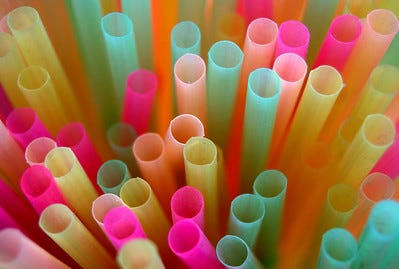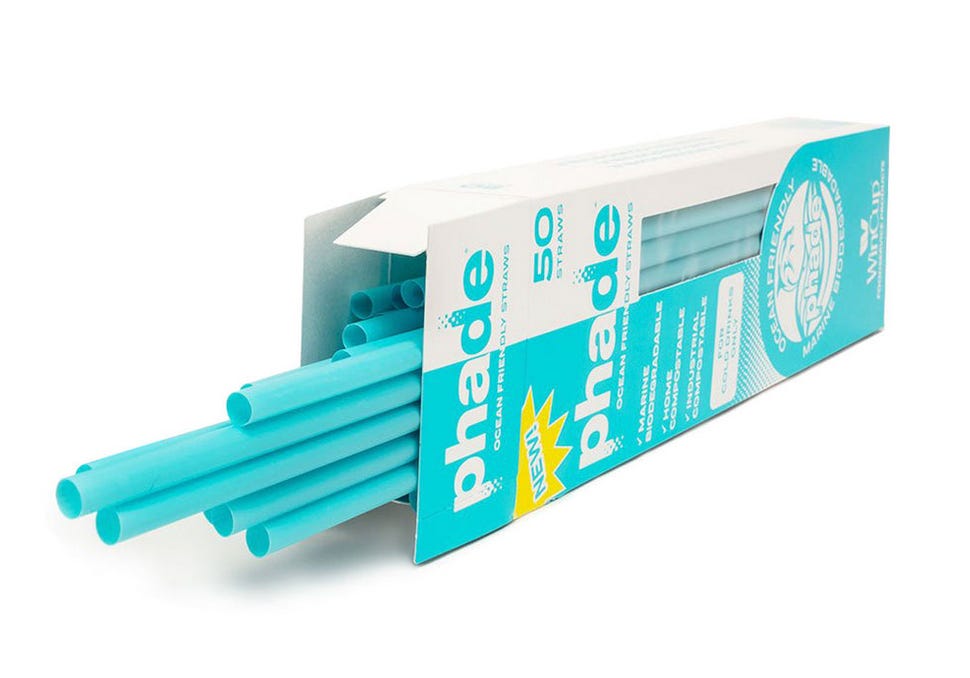The plastic pollution crisis
In this issue: Is there such a thing as a good straw? The non-stick pan brouhaha, pit-less cherries and how writers write.
This past May, when I was in Asia, I fruitlessly searched for bamboo straws. At home I use a metal straw but it gets too hot for my tea habit. If they were glass, I’d break them. My silicone straws work great for tea but I’m not confident I should be heating silicone up and sticking it in my mouth. (Is it 100% silicone? What’s in the coloring? Who knows.)
It’s damn hard to navigate what’s “best.”
Straws are a mindless, simple item. Millions upon millions are used daily. They’re accepted to be single-use, and when we see them on the ground it’s like, whatever. I’ve used straws made of corn, pasta, sugarcane and seaweed. They’re okay but not easily found and I’m never near a green bin when I need one. Paper drinking straws are almost always terrible. When I’m out I skip straws entirely. (I also try to skip lids.)
Yes, I’m thinking about straws. But I’m not alone. Researchers at Woods Hole Oceanographic Institution (WHOI) in Massachusetts looked into 13 different drinking straws on the market now. They weighed and measured the straws and ran them under water. They evaluated effectiveness and trade-offs of material, design choices and marketing claims. “Making the most appropriate material selection decision is imperative because, once entrenched, transitioning products to new materials faces significant inertia.” Significant inertia!
One question researchers had was whether a product should be biobased, but persistent polypropylene (PP) or fossil-based, but compostable poly(butylene adipate terephthalate) (PBAT)? Compostable is a huge problem even when a city has infrastructure to process it. Why is this? Because most compostable waste streams are cluttered with non-compostables. Imagine the facility that gets all the take-out forks from San Francisco? Some are plastic and some are compostable. Instead of any being composted, they’re all fished out and tossed in landfill. (Tears.)
Because so much waste winds up in our ocean, biodegradability in sea water was a key method evaluated. (An estimated 15 million metric tons of plastic enter the world’s ocean and waterways each year according to the The Pew Charitable Trust.) “While many straws are certified compostable and claim biodegradability, few present evidence for their degradation in the marine environment, where these items are ubiquitous.”
To test how biodegradable straws were — the number one marketing claim — researchers “incubated the straws for 30 weeks in a continuous flow seawater…to assess the mass loss rates of the straws under coastal seawater conditions.” Paper straws lost 70% of their mass during this period, which was the highest amount but didn’t crown paper king. Why? Because paper uses more material than plastic and requires 10 to 100 times more water to produce than bioplastics.
Disposal of compostable drinking straws resulted in additional and more potent greenhouse gas emissions — about six times more per straw — that otherwise would not have been produced. Why? Because anaerobic landfill conditions produce CH4 during the biodegradation of the material that escapes collection. A conventional plastic straw has zero global warming potential in compost or landfills because nothing happens to it in these environments. It just remains a plastic straw in perpetuity. Give or take millennia.
The winner, researchers determined, was a drinking straw made from plastic called polyhydroxyalkanoate (PHA). It’s produced by fermentation, using various carbon sources as feedstocks, such as methane from wastewater, cattle farming, landfills, and coal mining as the carbon source, yielding a carbon offsetting material. It can be composted on land and breaks down in the ocean in an estimated 15 months. It was the lightest and thinnest product, earning it sustainability points, which even though it lost less mass under water than paper, 30–50%, this still didn’t lower it’s ranking.
Have you been thinking about straws or looking for that mythical bamboo straw? In any event, here’s a box of PHA straws you can try out. Is there an everyday object you wish could be reinvented? Let me know.
The study was published in August 2025 in Environmental Science and Technology. Via Anthropocene.
I’m just here for the tidbits:
The state of California has a bill headed to the floor to phase out forever chemicals (aka PFAS) on everyday items including food packaging, dental floss and nonstick cooking pans. Chefs and actors are getting involved in the argument because well, California. I was surprised to learn that Minnesota has already banned PFAS in cookware and there are more states hoping to follow. (As a floss lover, I’m obsessed with plastic-free drTung’s.) What do we do with these “bad” pans? Maybe a big sculpture for Burning Man?
Pairwise, an expert in plant genetics, has been busy in the labs tinkering with fruits and veggies to create varieties we might appreciate more. The company created less spicy mustard greens and seedless blackberries. (Yes on blackberries but no way on un-spicy greens.) The company announced its working on pit-less cherries now! OMG. Sounds great but I might miss spitting seeds into my hand and looking for a place to toss it. You?
Wonder how writers write, or maybe you want to see where they write? Here’s the desk view of 12 writers nominated in the past for the Booker Prize. Via Wallpaper.
What I’m reading:
Are you watching Season 16 of the Great British Bake Off? I am. If you’re a baker or a person like me who likes to eat baked goods and likes to watch bakers baking, here’s a behind-the-scenes in the New Yorker by Rubi Tandoh, a past contestant. Here’s my favorite quote: “Then Paul Hollywood would close in across the lawn, his silver quiff cutting the air like a fin.” IYKYK
I enjoyed The Ministry of Time by Kaliane Bradley, which features real characters from the past who appear in the present day — vaguely future-ish — by government-assisted time travel. There’s a bit of controversy around this book because there’s also a Spanish book, and television show with the same name. The BBC is creating a show about the UK book. Uh-oh.
I just started The Anomaly by Hervé Le Tellier. I’m into it.


